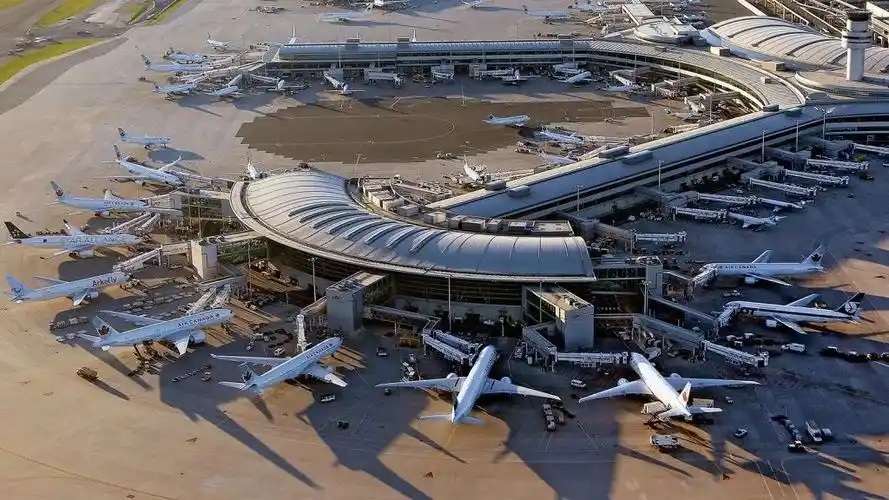Efficient and reliable network communication is crucial in the construction and operation of modern airport terminals. Industrial switches, as key network equipment, play a decisive role in ensuring the stable operation of various airport services through high-density deployment in airport terminals.

The airport terminal is a highly densely populated and complex place, covering numerous systems that require network support. For example, the flight information display system needs to display real-time and accurate information such as takeoff and landing times, boarding gate changes, etc. to passengers. According to relevant data, the daily number of flights taking off and landing at large airports can reach thousands. Such a huge amount of data, without stable network transmission, the timeliness and accuracy of information will be difficult to guarantee. The monitoring system is equally indispensable, as it needs to comprehensively monitor various areas within the terminal, such as the waiting hall, security checkpoint, baggage claim area, etc., to ensure passenger safety and the normal operation order of the airport. There is also the passenger Wi Fi system. With the popularization of mobile Internet, the demand of passengers for airport network services is growing. Taking Terminal 2 of Nanning Airport as an example, after completing the Wi Fi 6 upgrade, seamless signal coverage has been achieved within the terminal, allowing passengers to easily connect to a high-speed and stable network. This not only enhances the passenger experience, but also puts higher demands on the stability and bandwidth of the network.
In the selection of industrial switches, multiple key factors need to be comprehensively considered. Firstly, the port density needs to meet the access requirements of a large number of devices in the terminal building. For example, some industrial switches have up to 48 or even more Ethernet ports, which can effectively reduce the number of switches used, lower wiring complexity and costs. Next is performance, and high-speed data forwarding capability is crucial. Switches that support 10 Gigabit or even higher speeds can ensure the instantaneous transmission of large amounts of data and avoid network congestion. Meanwhile, reliability is also an important factor that cannot be ignored. Due to the special nature of airport operations, long-term network interruptions are not allowed, so industrial switches need to have redundant power supply, hot plugging and other functions. For example, some switches are equipped with dual power modules. When one power supply fails, the other can immediately take over the work to ensure the continuous operation of the equipment. Moreover, considering the complex environment such as electromagnetic interference that may exist within the airport, the switch should also have good anti-interference ability and a wide temperature working range.
The deployment architecture of industrial switches in airport terminals usually adopts a layered design. The access layer is responsible for connecting various terminal devices, such as cameras, displays, APs, etc. The aggregation layer aggregates data from multiple access layer switches and uploads it to the core layer. As the hub of the entire network, the core layer has powerful processing capabilities and high-speed data exchange capabilities, responsible for connecting with external networks and other critical systems. In this architecture, switches at different layers cooperate with each other to ensure smooth transmission of network data. For example, in the information network construction project of Chengdu Tianfu International Airport, Enchuang's POE industrial switches, access industrial switches, aggregation industrial switches and other products were used to ensure the smooth operation of the airport's information network through reasonable layered deployment.
When deploying industrial switches at high densities, there are also many challenges to be faced. One of the issues is heat dissipation. Placing many switches together can generate a large amount of heat. If the heat dissipation is poor, it can affect device performance and even lead to malfunctions. This can be solved by optimizing the layout of the computer room, adding ventilation and heat dissipation equipment, such as installing high-power air conditioners and setting up heat dissipation ducts. Network management is also a major challenge, as configuring and monitoring a large number of switches requires a significant amount of manpower and time. At this point, intelligent network management software can be used to achieve centralized management of switches, real-time monitoring of device status, traffic and other information, and timely detection and resolution of problems. At the same time, the complexity of cabling will also increase due to high-density deployment, which requires reasonable planning of cable routing, proper cable identification, and the use of high-quality cables during the cabling process to ensure cabling quality and network performance.
With the continuous development of technology, the application of industrial switches in airport terminals will also continue to evolve. In the future, higher performance and more intelligent industrial switches will continue to emerge, providing more solid network support for the efficient operation and intelligent development of airports, helping airports improve service quality, and bringing passengers a more convenient and comfortable travel experience.
